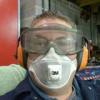You're right that the obvious thing would to be to try smaller carbs whatever the configuration - one, twins, one per cylinder. Typically the choice for Minis is one 1,3/4 carb or a pair of 1,1/4's both options have a similar cross sectional area. As Capt Maimwaring states above area increases exponentially related to diameter. To lift a piston with pressure (pounds per square inch) it helps to have more square inches.

D.vizard Tuning Bl's A Series And Twin Carbs
#31

Posted 09 June 2013 - 12:55 AM
#32

Posted 09 June 2013 - 01:38 AM
I'm still not convinced by simple gas velocity theories - if you double the number of carbs you half the quantity of gas that each flows.
I'm thinking it's down to the fact that you'd use smaller carbs on twin setups. Being smaller they actually require less gas velocity for the piston to accelerate. So though you've reduced the actual gas that each carb is flowing, less flow is required to get that accelaration. I'm guessing (and of course this could be complete codswallop) that if you swtiched from a single HS4 to a single HS2 you'd get this same benefit, but probally wouldn't notice because you're now under carbed.
It's like if you tried to force a cubic meter of gas through a square meter in precisely 1 second, you would need to apply less presssure than if you were to push it through a square centimeter in the same time frame. (Thanks Cpt. Obvious...)
If acceleration of the piston was the issue...why do SU damp and spring that action?
The piston is lifted by differential pressure - you could have it lift as fast as depression is generated across the choke - remember that DP is a function of the square of the gas velocity.
Do you remember the original 8 port set ups, with 4 little amal carbs linked up?
Well you're getting close....
Trouble is because a circle has less perimeter are (read circumference) relative to it's area the bigger it gets and thus less restriction (read "friction").
When dealing with gases, if you take a gas at a velocity and run it through a restriction you'll generate a differential pressure, in other words, a velocity head is converted into a pressure head through an orifice. In an SU carb, that restriction is designed to be self adjusting relative to the gas volume, to create a constant velocity, the problem being that not only the choke create a restriction, but the walls of the car do too, and this is what limits ultimate flow (breathing) through the carb.
Try to forget the piston limiting acceleration, it's just not the case - in fact the action of the piston needs to be damped for normal running - to stop flutter at constant speed, but also to prevent the piston rising to fast, causing an over rich mixture during acceleration.
#33

Posted 09 June 2013 - 03:26 AM
You're right that the obvious thing would to be to try smaller carbs whatever the configuration - one, twins, one per cylinder. Typically the choice for Minis is one 1,3/4 carb or a pair of 1,1/4's both options have a similar cross sectional area. As Capt Maimwaring states above area increases exponentially related to diameter. To lift a piston with pressure (pounds per square inch) it helps to have more square inches.
You could make the piston bigger - but then that means that the volume above the piston is bigger and thus it takes longer for the DP to form and the piston to lift.
Take your carb scenario:-
1) A 1.75" SU has a cross section area of 2.4"^2 and a wide open choke circ of 5.5"
2) A 1.25" SU has a cross section area of 1.22"^2 and a wide open choke circ of 3.9"
We need two 1.25" SU's to give us the same CSA as a 1.75" SU, but the problem is that even though the CSA is nearly the same, the circumference of the chokes for the two 1.25" carb would be 7.8" relative to the 5.5" of the single 1.75" carb.
At low airflows, this is no problem, as losses increase with the square of the speed, but at higher airflows, the big single romps ahead of the small twins in terms of reduced restriction and thus differential pressure. Remember, the lower DP across the carb, th higher the maximum potential airflow is.
#34

Posted 09 June 2013 - 08:22 AM
#35

Posted 09 June 2013 - 09:30 AM
Sunday morning... I was dazed, now I am most certainly confused ![]()
#36

Posted 09 June 2013 - 09:38 AM
Try to forget the piston limiting acceleration, it's just not the case - in fact the action of the piston needs to be damped for normal running - to stop flutter at constant speed, but also to prevent the piston rising too fast, causing an over rich mixture during acceleration.
Weak mixture............
Yep....sorry ![]()
#37

Posted 09 June 2013 - 09:54 AM
fit a weber #induction noise
#38

Posted 09 June 2013 - 10:27 AM
fit a weber #induction noise
If I want plenty of trumpet, I'll put the wife in the car. The minute I start doing what you're supposed to do in a mini, she starts screaming her titties off, drowns out pretty much any sort of mechanical noise.
#39

Posted 09 June 2013 - 10:43 AM
That's precisely the reason why twins can function better that the single SU as all su's need to be damped to work correctly. A pair of SU's piston can rise at a rate to allow air to enter the engine in sufficient quality even in lower gears to realise full acceleration without affecting acceleration enrichment. A big single lags behind in this single respect. If moves are taken to allow the piston to rise faster on a single setup, the damping effect is reduced and compensation for needle enrichment is needed. This upsets the balance of calibration between steady state and acceleration enrichment, giving rise to a compromise on fueling. With correctly sized twins this simply is not a problem.
Lower gearing just makes the problem more apparent.
AC
Edited by ACDodd, 09 June 2013 - 10:45 AM.
#40

Posted 09 June 2013 - 11:07 AM
That's precisely the reason why twins can function better that the single SU as all su's need to be damped to work correctly. A pair of SU's piston can rise at a rate to allow air to enter the engine in sufficient quality even in lower gears to realise full acceleration without affecting acceleration enrichment. A big single lags behind in this single respect. If moves are taken to allow the piston to rise faster on a single setup, the damping effect is reduced and compensation for needle enrichment is needed. This upsets the balance of calibration between steady state and acceleration enrichment, giving rise to a compromise on fueling. With correctly sized twins this simply is not a problem.
Lower gearing just makes the problem more apparent.
AC
Yes, there is insufficient depression at the jet because the choke is too big for slow speed running - you could get the piston to rise quicker, no problem, but it still doesn't help you as the SU relies on the damper slowing the rise of the needle and generating a higher velocity and thus suction relative to atmospheric to provide excess fuel during hard acceleration - as soon as the piston rises, that depression is lost, and the suction is reduced, and so is the acceleration enrichment.
Personally I don't think the rise of the damper is the issue, that could be sorted easily - the issue is with too low gas velocity through the choke at reduced RPM's - all the advantage you have from the free flowing body is lost as there isn't enough huff to generate sufficient enrichment thus the rise is gas velocity is reduced with regard to a small twin set up.
The damping is not only to control rate of rise, it's also to control piston flutter as a result of unstable airflow through the carb causing stuttering or surging.
#41

Posted 09 June 2013 - 01:57 PM
Well it's the afternoon now ![]() so,
so,
The consensus is:
Larger carbs are more efficient, and capable of producing more power (given equal total cross section cross all carbs) by virtue of the ratio of cross sectional area to surface area (for frictional losses).
Now for carb piston response:
We need to decide if we are comparing 2 small carbs as a single entity against 1 bigger carb (same CSA yada, yada...) OR carb against carb - in which case we should take into account one of a pair of carbs is feeding half the engine, with half the total gas flow going through it.
The first approach seems the most direct so,
To maintain a constant depression you need the same total cross sectional choke area (each half of a twin choke setup would contribute half the area, but flowing half an engine's worth of gas volume would require the same gas velocity. Lets say we need half the total flow potential of the carburation, all the pistons will need to go half way to full lift i.e. half the choke diameter. The 1,3/4 choke needs to lift its piston 22mm whereas each 1,1/4 needs to raise 16mm. At first sight it looks like it's advantage twins, but it's the depression created by the choke(s) that has to lift the pistons so we also have to consider the rate of change in depression as the piston rises - or, more accurately, the increase in gas velocity required to keep it the same . We know it's related to the choke area and that's scalar to lift - raising our single piston 1mm only requires 16/22ths of the increase in gas velocity of our smaller pair. That's without considering the frictional losses or total piston masses. both of which favour the single big carb.
It does occur to me - are piston to choke areas in the same proportions across the SU range - it's a no brainer if baby carbs have piston to choke proportions like puppy dog eyes.
#42

Posted 10 June 2013 - 11:33 AM
Well it's the afternoon now
so,
The consensus is:
Larger carbs are more efficient, and capable of producing more power (given equal total cross section cross all carbs) by virtue of the ratio of cross sectional area to surface area (for frictional losses).
Now for carb piston response:
We need to decide if we are comparing 2 small carbs as a single entity against 1 bigger carb (same CSA yada, yada...) OR carb against carb - in which case we should take into account one of a pair of carbs is feeding half the engine, with half the total gas flow going through it.
The first approach seems the most direct so,
To maintain a constant depression you need the same total cross sectional choke area (each half of a twin choke setup would contribute half the area, but flowing half an engine's worth of gas volume would require the same gas velocity. Lets say we need half the total flow potential of the carburation, all the pistons will need to go half way to full lift i.e. half the choke diameter. The 1,3/4 choke needs to lift its piston 22mm whereas each 1,1/4 needs to raise 16mm. At first sight it looks like it's advantage twins, but it's the depression created by the choke(s) that has to lift the pistons so we also have to consider the rate of change in depression as the piston rises - or, more accurately, the increase in gas velocity required to keep it the same . We know it's related to the choke area and that's scalar to lift - raising our single piston 1mm only requires 16/22ths of the increase in gas velocity of our smaller pair. That's without considering the frictional losses or total piston masses. both of which favour the single big carb.
It does occur to me - are piston to choke areas in the same proportions across the SU range - it's a no brainer if baby carbs have piston to choke proportions like puppy dog eyes.
Yes and kind of - your calcs forget that DP (differential or what will be doing the lifting) is proportion to the square of the rate of flow (alias square law). Small carbs can achieve a much higher rate of flow...therefore higher DP......and with a smaller mass (not so important) and a smaller volume of air to exhaust (dashpot volume) over the top of the piston - thus a quicker response.
#43

Posted 10 June 2013 - 02:27 PM
Surely the rate of flow depends on the demands of the engine - if you are sucking 100 litres a minute it won't matter whether it's its through one or two orifices as long as they have the same total area. You could be stuffing Toblerones into a cardboard box, it would make no difference if you had 2 triangular holes or a bigger square hole that accepted two at a time. You'd have to push chocolate at the same rate to fill the box in the same time.
Of course air is elastic, if chocolate was too (and you were pulling, like an engine) the additional friction in the triangular holes would stretch your Toblerones more resulting in a lower choccy yield (by weight).
You've lost me over the piston mass - it's waiting for the air in the suction chamber to get out of the way and that has considerably less mass that needs to be accelerated by the force created by the venturi pressure differential. The more favourable the piston's mass to surface area ratio the quicker it will accelerate upwards under a given suction chamber vacuum.
(I apologise to any Swiss Choccy enthusiasts for not recognising a brace of Toblerones would actually constitute a rhomboid other than a square.)
#44

Posted 10 June 2013 - 09:59 PM
Ah for once I do know a fact, take a circle of two square inches and 2 one square inch circles. Both have when fully uncovered a total surface of 2 square inches. However, as your butterflies open up on both setups, until you reach a certain point the two smaller circles will show a larger surface area than the larger one.
This is a fact, is it relevant? Not sure. ![]()
I suppose it would be relevant as you slowly open the throttle, the two small holes would let more air through.
#45

Posted 10 June 2013 - 10:13 PM
You have it.
AC
0 user(s) are reading this topic
0 members, 0 guests, 0 anonymous users
















